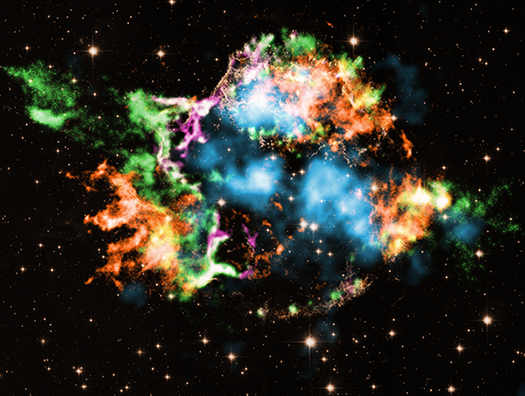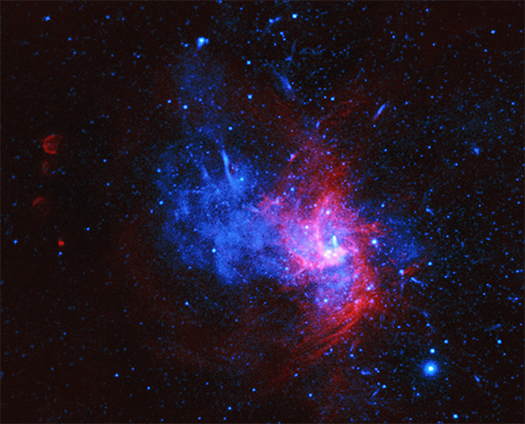Supernovas & Supernova Remnants
Bubbles With Titanium Trigger Titanic Explosions
Astronomers using NASA's Chandra X-ray Observatory have announced the discovery of an important type of titanium, along with other elements, blasting out from the center of the supernova remnant Cassiopeia A (Cas A). This new result, as outlined in our latest press release, could be a major step for understanding exactly how some of the most massive stars explode.
The different colors in this new image mostly represent elements detected by Chandra in Cas A: iron (orange), oxygen (purple), and the amount of silicon compared to magnesium (green). Titanium (light blue) detected previously by NASA's NuSTAR telescope at higher X-ray energies is also shown. These Chandra and NuSTAR X-ray data have been overlaid on an optical-light image from the Hubble Space Telescope (yellow).
On the Hunt for a Hidden Neutron Star
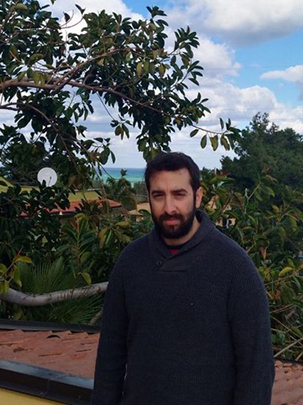
Emanuele Greco
We are pleased to welcome Emanuele Greco as a guest blogger. Emanuele is the first author of a paper describing the possible discovery of a neutron star left behind by supernova 1987A. Emanuele received a master’s degree in Physics at the University of Palermo in 2017. He is now completing his PhD in Astrophysics at the same University, where he is expected to defend his thesis next June. He spent six months of his PhD at the Anton Pannekoek Instituut of the University of Amsterdam. Emanuele’s main research interests deal with the X-ray spectroscopy of supernova remnants and objects embedded within their shells, with a particular focus on the different processes that generate X-ray emission.
Imagine having a bright and small light bulb and putting it behind a thick wall made of elements like iron and silicon. No light stemming from the bulb would be observed, because it is completely obscured by the wall. This quite simple scenario is perfectly suited also for the elusive compact object of supernova (SN) 1987A, which was investigated by scientists from University of Palermo (UniPa), INAF-Observatory of Palermo (OAPa), Astrophysical Big Bang Laboratory (RIKEN) and University of Kyushu.
SN 1987A is the only naked-eye SN observed since telescopes were invented and offers a unique opportunity to watch a SN evolving into a supernova remnant (SNR) in this time of multi-wavelength and multi-messenger observatories simultaneously at work. This event was particularly important because neutrinos emitted from an exploding star were detected on Earth for the first time. This discovery implies that the core of the progenitor star must have collapsed producing a shock wave — similar to the sonic boom from a supersonic plane — that ejected part of the stellar material into the surrounding environment. As a result, a compact object such as a neutron star, a relic of the stellar core, should have formed in the very heart of SN 1987A. However, despite the continuous monitoring performed at almost all wavelengths since the SN was detected, no clear indication for this compact object has been found so far. Various hypotheses have been proposed to explain this non-detection, such as the formation of a black hole instead of a neutron star.
Rare Blast's Remains Discovered in Milky Way Center
Astronomers have found evidence for an unusual type of supernova near the center of the Milky Way galaxy, as reported in our latest press release. This composite image contains data from NASA's Chandra X-ray Observatory (blue) and the NSF's Very Large Array (red) of the supernova remnant called Sagittarius A East, or Sgr A East for short. This object is located very close to the supermassive black hole in the Milky Way's center, and likely overruns the disk of material surrounding the black hole.
Researchers were able to use Chandra observations targeting the supermassive black hole and the region around it for a total of about 35 days to study Sgr A East and find the unusual pattern of elements in the X-ray signature, or spectrum. An ellipse on the annotated version of the images outlines the region of the remnant where the Chandra spectra were obtained.
Data Sonification: Sounds from Around the Milky Way
Your browser does not support the video tag.
The center of our Milky Way galaxy is too distant for us to visit in person, but we can still explore it. Telescopes give us a chance to see what the Galactic Center looks like in different types of light. By translating the inherently digital data (in the form of ones and zeroes) captured by telescopes in space into images, astronomers create visual representations that would otherwise be invisible to us.
But what about experiencing these data with other senses like hearing? Sonification is the process that translates data into sound, and a new project brings the center of the Milky Way to listeners for the first time. The translation begins on the left side of the image and moves to the right, with the sounds representing the position and brightness of the sources. The light of objects located towards the top of the image are heard as higher pitches while the intensity of the light controls the volume. Stars and compact sources are converted to individual notes while extended clouds of gas and dust produce an evolving drone. The crescendo happens when we reach the bright region to the lower right of the image. This is where the 4-million-solar-mass supermassive black hole at the center of the Galaxy, known as Sagittarius A* (A-star), resides, and where the clouds of gas and dust are the brightest.
Users can listen to data from this region, roughly 400 light years across, either as "solos" from NASA's Chandra X-ray Observatory, Hubble Space Telescope, and Spitzer Space Telescope, or together as an ensemble in which each telescope plays a different instrument. Each image reveals different phenomena happening in this region about 26,000 light years from Earth. The Hubble image outlines energetic regions where stars are being born, while Spitzer's infrared image shows glowing clouds of dust containing complex structures. X-rays from Chandra reveal gas heated to millions of degrees from stellar explosions and outflows from Sagittarius A*.
In addition to the Galactic Center, this project has also produced sonified versions of the remains of a supernova called Cassiopeia A, or Cas A, and the "Pillars of Creation" located in Messier 16.
NASA's Chandra Opens Treasure Trove of Cosmic Delights
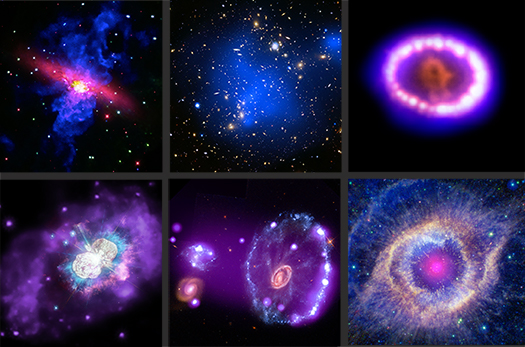
Chandra Archive Collection: A Montage of Light From Space
Credit: NASA/CXC/SAO, NASA/STScI, NASA/JPL-Caltech/SSC, ESO/NAOJ/NRAO, NRAO/AUI/NSF, NASA/CXC/SAO/PSU, and NASA/ESA
Humanity has "eyes" that can detect all different types of light through telescopes around the globe and a fleet of observatories in space. From radio waves to gamma rays, this "multiwavelength" approach to astronomy is crucial to getting a complete understanding of objects in space.
This compilation gives examples of images from different missions and telescopes being combined to better understand the science of the universe. Each of these images contains data from NASA's Chandra X-ray Observatory as well as other telescopes. Various types of objects are shown (galaxies, supernova remnants, stars, planetary nebulas), but together they demonstrate the possibilities when data from across the electromagnetic spectrum are assembled.
Debris from Stellar Explosion Not Slowed After 400 Years
Astronomers have used NASA's Chandra X-ray Observatory to record material blasting away from the site of an exploded star at speeds faster than 20 million miles per hour. This is about 25,000 times faster than the speed of sound on Earth.
Kepler's supernova remnant is the debris from a detonated star that is located about 20,000 light years away from Earth in our Milky Way galaxy. In 1604 early astronomers, including Johannes Kepler who became the object's namesake, saw the supernova explosion that destroyed the star.
We now know that Kepler's supernova remnant is the aftermath of a so-called Type Ia supernova, where a small dense star, known as a white dwarf, reaches a critical mass limit after interacting with a companion star and undergoes a thermonuclear explosion that shatters the white dwarf and launches its remains outward.
The latest study tracked the speed of 15 small "knots" of debris in Kepler's supernova remnant, all glowing in X-rays, all glowing in X-rays. The fastest knot was measured to have a speed of 23 million miles per hour, the highest speed ever detected of supernova remnant debris in X-rays. The average speed of the knots is about 10 million miles per hour, and the blast wave is expanding at about 15 million miles per hour. These results independently confirm the 2017 discovery of knots travelling at speeds more than 20 million miles per hour in Kepler's supernova remnant.
Researchers in the latest study estimated the speeds of the knots by analyzing Chandra X-ray spectra, which give the intensity of X-rays at different wavelengths, obtained in 2016. By comparing the wavelengths of features in the X-ray spectrum with laboratory values and using the Doppler effect, they measured the speed of each knot along the line of sight from Chandra to the remnant. They also used Chandra images obtained in 2000, 2004, 2006 and 2014 to detect changes in position of the knots and measure their speed perpendicular to our line of sight. These two measurements combined to give an estimate of each knot's true speed in three-dimensional space. A graphic gives a visual explanation for how motions of knots in the images and the X-ray spectra were combined to estimate the total speeds.
When An Unstoppable Force Meets an Immovable Object
The explosions of dying stars, known as supernovas, are some of the most powerful events in our entire universe, releasing more energy than the Sun will in its entire 10-billion-year lifetime. (The Sun is no small player, either—it produces the energy of nearly a trillion 1 megaton bombs every 10 seconds.)
The sheer power of a supernova explosion is enough to blast out debris at speeds of around 20 million miles per hour, generating shockwaves – pressure wavefronts that move faster than the speed of sound as they collide with surrounding gas and dust. As the shockwaves radiate outward into space, they dramatically heat this material up to temperatures of tens of millions of degrees, causing the supernova remnant to glow in X-rays.
Such immense, swift forces may seem completely unstoppable, but in the case of one supernova remnant in our Galaxy, G21.5-0.9, images from NASA's Chandra X-ray Observatory reveal that a mysterious presence was able to stop G21.5-0.9's shockwaves in their tracks.

Supernova remnant G21.5-0.9
(Credit: NASA/CXC/U.Manitoba/H.Matheson & S.Safi-Harb)
Stellar Explosions and Jets Showcased in New Three Dimensional Visualizations
Your browser does not support the video tag.
Compilation of 3D Models
Credit: NASA/CXC/INAF-Osservatorio Astronomico di Palermo/Salvatore Orlando
Since ancient times, the study of astronomy has largely been limited to the flat, two-dimensional projection of what appears on the sky. However, just like a botanist puts a plant under a microscope or a paleontologist digs for fossils, astronomers want more "hands on" ways to visualize objects in space.
A new set of computer simulations represents an exciting step in that direction. Each is a three-dimensional (3D) visualization of an astronomical object based on data from NASA's Chandra X-ray Observatory and other X-ray observatories. While unable to fly to these distant objects and travel around them, astronomers have used data from these observatories to learn about the geometry, velocity, and other physical properties of each of these cosmic sources.
NASA's Great Observatories Help Astronomers Build a 3D Visualization of Exploded Star
In the year 1054 AD, Chinese sky watchers witnessed the sudden appearance of a "new star" in the heavens, which they recorded as six times brighter than Venus, making it the brightest observed stellar event in recorded history. This "guest star," as they described it, was so bright that people saw it in the sky during the day for almost a month. Native Americans also recorded its mysterious appearance in petroglyphs.
Observing the nebula with the largest telescope of the time, Lord Rosse in 1844 named the object the "Crab" because of its tentacle-like structure. But it wasn't until the 1900s that astronomers realized the nebula was the surviving relic of the 1054 supernova, the explosion of a massive star.
Now, astronomers and visualization specialists from the NASA's Universe of Learning program have combined the visible, infrared, and X-ray vision of NASA's Great Observatories to create a three-dimensional representation of the dynamic Crab Nebula. Certain structures and processes, driven by the pulsar engine at the heart of the nebula, are best seen at particular wavelengths.
Tycho's Supernova Remnant: The Clumpy and Lumpy Death of a Star
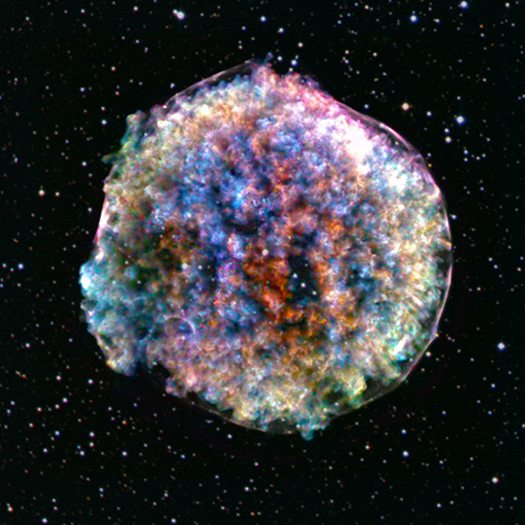
Tycho's Supernova Remnant
Credit: X-ray: NASA/CXC/SAO.; Optical: DSS
In 1572, Danish astronomer Tycho Brahe was among those who noticed a new bright object in the constellation Cassiopeia. Adding fuel to the intellectual fire that Copernicus started, Tycho showed this "new star" was far beyond the Moon, and that it was possible for the Universe beyond the Sun and planets to change.
Astronomers now know that Tycho's new star was not new at all. Rather it signaled the death of a star in a supernova, an explosion so bright that it can outshine the light from an entire galaxy. This particular supernova was a Type Ia, which occurs when a white dwarf star pulls material from, or merges with, a nearby companion star until a violent explosion is triggered. The white dwarf star is obliterated, sending its debris hurtling into space.

